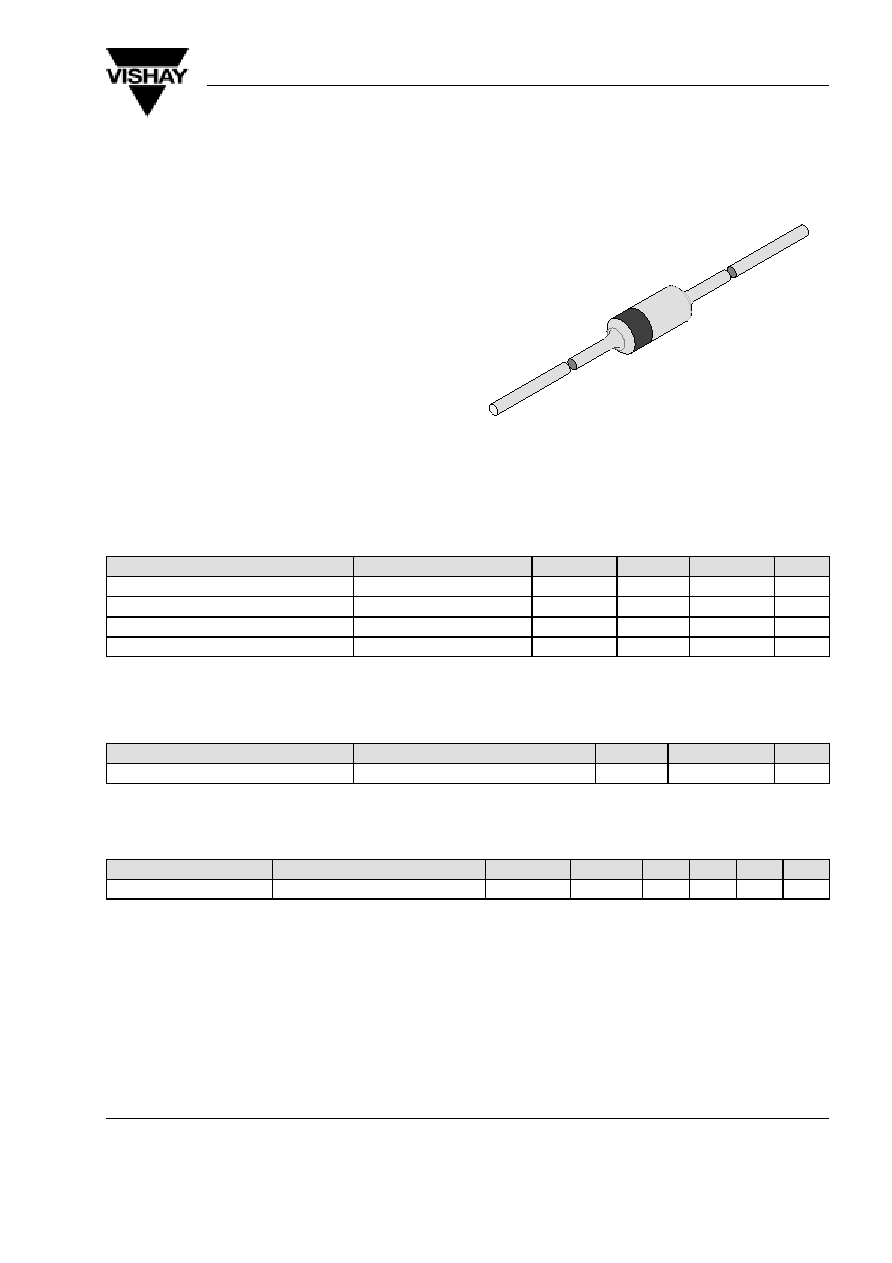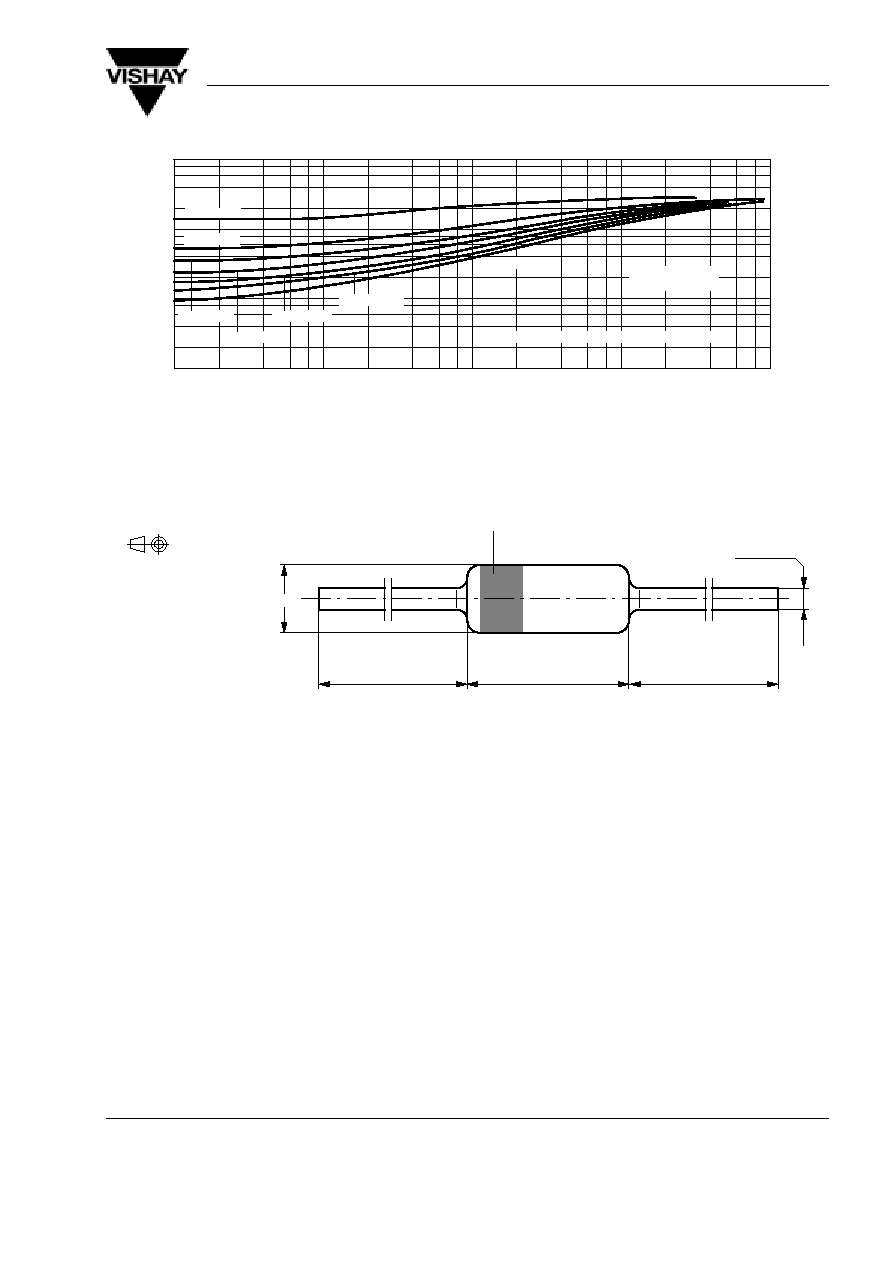
1N4678...1N4717
Vishay Telefunken
Rev. 2, 01-Apr-99
3 (6)
www.vishay.de
∑
FaxBack +1-408-970-5600
Document Number 85586
1.) Toleranzing and voltage designation (V
Z
).
The type numbers shown have a standard tolerance of
±
5% on the nominal zener voltage.
2.) Maximum zener current ratings (I
ZM
).
Maximum zener current ratings are based on maximum zener voltage of the individual units.
3.) Reverse leakage current (I
R
).
Reverse leakage currents are guaranteed and measured at V
R
as shown on the table.
4.) Maximum voltage change (
D
V
Z
).
Voltage change is equal to the difference between V
Z
at 100
m
A and V
Z
at 10
m
A.
Characteristics (T
j
= 25
_
C unless otherwise specified)
0
40
80
120
160
0
100
300
400
500
600
P
≠
T
otal Power Dissipation ( mW
)
tot
T
amb
≠ Ambient Temperature (
∞
C )
200
95 9602
200
Figure 1. Total Power Dissipation vs.
Ambient Temperature
0
5
10
15
20
1
10
100
1000
V
≠
V
oltage
Change
(
mV
)
Z
V
Z
≠ Z-Voltage ( V )
25
95 9598
D
I
Z
=5mA
T
j
= 25
∞
C
Figure 2. Typical Change of Working Voltage
under Operating Conditions at T
amb
=25
∞
C
≠60
0
60
120
180
0.8
0.9
1.0
1.1
1.2
1.3
V
≠ Relative
V
oltage
Change
Ztn
T
j
≠ Junction Temperature (
∞
C )
240
95 9599
V
Ztn
=V
Zt
/V
Z
(25
∞
C)
TK
VZ
=10
10
≠4
/K
8
10
≠4
/K
≠4
10
≠4
/K
6
10
≠4
/K
4
10
≠4
/K
2
10
≠4
/K
≠2
10
≠4
/K
0
Figure 3. Typical Change of Working Voltage vs.
Junction Temperature
0
10
20
30
≠5
0
5
10
15
TK ≠
T
emperature
Coef
ficient of
V
( 10 /K
)
VZ
V
Z
≠ Z-Voltage ( V )
50
95 9600
40
Z
≠4
I
Z
=5mA
Figure 4. Temperature Coefficient of Vz vs.
Z≠Voltage

1N4678...1N4717
Vishay Telefunken
Rev. 2, 01-Apr-99
4 (6)
www.vishay.de
∑
FaxBack +1-408-970-5600
Document Number 85586
0
5
10
15
0
50
100
150
200
C ≠ Diode Capacitance ( pF )
D
V
Z
≠ Z-Voltage ( V )
25
95 9601
20
T
j
= 25
∞
C
V
R
= 2V
Figure 5. Diode Capacitance vs. Z≠Voltage
0
0.2
0.4
0.6
0.8
0.001
0.01
0.1
1
10
100
1.0
95 9605
I ≠ Forward Current ( mA
)
F
V
F
≠ Forward Voltage ( V )
T
j
= 25
∞
C
Figure 6. Forward Current vs. Forward Voltage
0
4
8
12
16
20
95 9604
0
20
40
60
80
100
I ≠ Z-Current ( mA
)
Z
V
Z
≠ Z-Voltage ( V )
P
tot
=500mW
T
amb
=25
∞
C
Figure 7. Z≠Current vs. Z≠Voltage
15
20
25
30
0
10
20
30
40
50
I ≠ Z-Current ( mA
)
Z
V
Z
≠ Z-Voltage ( V )
35
95 9607
P
tot
=500mW
T
amb
=25
∞
C
Figure 8. Z≠Current vs. Z≠Voltage
0
5
10
15
20
1
10
100
1000
r ≠ Dif
ferential Z-Resistance ( )
Z
V
Z
≠ Z-Voltage ( V )
25
95 9606
W
T
j
= 25
∞
C
I
Z
=1mA
5mA
10mA
Figure 9. Differential Z≠Resistance vs. Z≠Voltage

1N4678...1N4717
Vishay Telefunken
Rev. 2, 01-Apr-99
6 (6)
www.vishay.de
∑
FaxBack +1-408-970-5600
Document Number 85586
Ozone Depleting Substances Policy Statement
It is the policy of Vishay Semiconductor GmbH to
1. Meet all present and future national and international statutory requirements.
2. Regularly and continuously improve the performance of our products, processes, distribution and operating
systems
with respect to their impact on the health and safety of our employees and the public, as well as their impact on
the environment.
It is particular concern to control or eliminate releases of those substances into the atmosphere which are known as
ozone depleting substances ( ODSs ).
The Montreal Protocol ( 1987 ) and its London Amendments ( 1990 ) intend to severely restrict the use of ODSs and
forbid their use within the next ten years. Various national and international initiatives are pressing for an earlier ban
on these substances.
Vishay Semiconductor GmbH has been able to use its policy of continuous improvements to eliminate the use of
ODSs listed in the following documents.
1. Annex A, B and list of transitional substances of the Montreal Protocol and the London Amendments respectively
2 . Class I and II ozone depleting substances in the Clean Air Act Amendments of 1990 by the Environmental
Protection Agency ( EPA ) in the USA
3. Council Decision 88/540/EEC and 91/690/EEC Annex A, B and C ( transitional substances ) respectively.
Vishay Semiconductor GmbH can certify that our semiconductors are not manufactured with ozone depleting
substances and do not contain such substances.
We reserve the right to make changes to improve technical design and may do so without further notice.
Parameters can vary in different applications. All operating parameters must be validated for each customer application
by the customer. Should the buyer use Vishay-Telefunken products for any unintended or unauthorized application, the
buyer shall indemnify Vishay-Telefunken against all claims, costs, damages, and expenses, arising out of, directly or
indirectly, any claim of personal damage, injury or death associated with such unintended or unauthorized use.
Vishay Semiconductor GmbH, P.O.B. 3535, D-74025 Heilbronn, Germany
Telephone: 49 ( 0 ) 7131 67 2831, Fax number: 49 ( 0 ) 7131 67 2423





